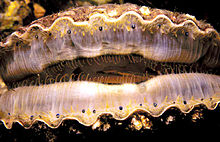Scallop
As a scallop or scallop are two closely related species of mussels referred to the genus of Pecten include the typical genus of scallops (Pectinidae) . Pecten jacobaeus , the Mediterranean pilgrim mussel , lives in the Mediterranean. The distribution area of the Pecten maximus ( large pilgrim mussel ) extends from the northern British Isles along the entire Atlantic coast to southern Portugal. The two Pecten species are among the largest and tastiest edible mussels.
anatomy
Like oysters, the pilgrim clams have a central sphincter muscle . Hence the characteristic scar inside the bowl. Since the pilgrim clams move by swimming, the muscle cord is much stronger than that of the oyster. Their shell has a regular pattern of 12 to 17 ribs, which is seen as the archetypal shape of the shell. Adults usually grow to 4 to 6 inches, but less often they can reach 8 inches.
Occurrence and catch
Scotland , France and Ireland are considered to be the best fishing areas for the great pilgrim mussel . The fishing season is from November to March. The mussels are offered frozen all year round. In Chile , related species (such as Argopecten purpuratus ) are also grown in aquaculture , for example in the Bay of Tongoy , and are also marketed as scallops.
In France there are significant scallop populations in the English Channel off the Norman coast. In terms of the amount of mussels fished, Port-en-Bessin is considered the most important fishing port in Lower Normandy . A festival has been celebrated every year since 2004 on the occasion of the new scallop season (beginning of October to mid-May). A good two thirds of French scallops are fished on the Normandy coast. Since the mussel is an endangered species, the catch for French fishermen is heavily regulated. Only specimens larger than 11 cm may be caught for sale. The so-called “red seal of approval” (Label Rouge) guarantees high quality standards for catching and selling .
For years there has been a dispute between French fishermen, who are only allowed to catch the scallop from October 1st to May 15th, and British fishermen, who are not subject to this regulation. At night on August 28, 2018, 40 French fishermen drove five British mussel fishermen away in their boats in the English Channel. Some boats suffered minor damage. The gendarmerie calmed the situation on site.
preparation
Fresh clams should be heavy and closed. To open, you put the flat bowl upwards and cut with a knife along the inside of the upper bowl and then fold up the flatter bowl. All black innards and the beard are removed. Only the cylindrical white muscle cord between the valves - also called a nut (English scallop ) - and the orange-red roe (fr. Corail ) are used. The meat has a nutty, slightly sweet taste.
Large scallops can be prepared in many ways, classically as a gratinated ragout in their own bowl. They are especially eaten raw in Japanese sushi kitchens, for example over a nigiri , a hand-formed ball of rice called Hotategai , the Ezo scallop ( Patinopecten yezoensis , Japanese 帆 立 貝).
Origin of names and symbols

The name "scallop" refers to St. James , who is considered the patron saint of pilgrims . He received the scallop shell posthumously as a distinguishing mark and usually wears it in depictions on his hat, coat or pocket. Due to this attribute, the scallop shell became a symbol of pilgrims, especially those on the Camino de Santiago, in the Middle Ages .
The Christian pilgrims of the Middle Ages used the scallop to draw water. A common custom among pilgrims to St. James was to end the pilgrimage 60 km further at Cap Finisterre in order to collect a real scallop from the sea. Worn as a pilgrim sign on a hat band or belt, it is historically connected to the pilgrimage to Santiago de Compostela to commemorate the visit to the tomb of St. James. The shell was more than just a souvenir. After returning home, it secured the reputation of its wearer, and many a former pilgrim to St. James had the shell laid in their graves.
See also
Web links
Individual evidence
- ↑ Species Fact Sheets: Pecten maximus (Linnaeus, 1758). FAO (English).
- ↑ L. Chauvaud, Y. Patry, A. Jolivet et al .: Variation in Size and Growth of the Great Scallop Pecten maximus along a Latitudinal Gradient. In: PLoS ONE , Vol. 7, No. 5, 2012, doi : 10.1371 / journal.pone.0037717 .
- ↑ Charlotte Marshall, Emily Wilson: Species Information for Pecten maximus . BIOTIC - Biological Traits Information Catalog, accessed September 22, 2019.
- ↑ Scallops. Tongoy.de ( Memento from March 4, 2016 in the Internet Archive ).
- ↑ Scallops: Conflict reignited in the English Channel. orf.at , August 29, 2018, accessed August 29, 2018.
- ↑ Fishermen fight a real sea battle for fishing grounds in the English Channel. watson.ch , August 29, 2018, accessed on September 5, 2018.
- ↑ Scallops - a delicacy and a symbol. Netzwissen.com, accessed on September 22, 2019.


